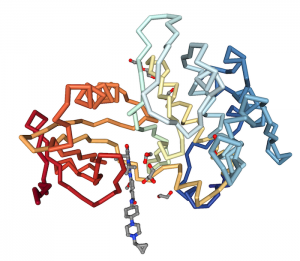Enter your address to receive notifications about new posts to your email.
Articles tagged Human Disease
(81 results)
-
Fly model of traumatic brain injury untangles factors tied to mortality
Each year, emergency departments in the US treat almost 700,000 people for traumatic brain injury (TBI). The outcome depends largely on the severity and location of the injury, but these aren’t the only factors. Age also plays a role, with children often recovering more fully than do adults. The patient’s diet following the injury may…
-
New schizophrenia risk genes found by computational analysis
Symptoms of schizophrenia most commonly begin to creep up in young adulthood. Although genetics play a major role in this complex disorder, narrowing down the search for the genes involved has proven frustratingly difficult. Risk loci identified by genome-wide association studies (GWAS) may contain several genes, making it unclear which of these contribute to pathology.…
-
High Temperatures Suppress Seizures in a Fruit Fly Epilepsy Model
The human brain is an amazing machine powered by electricity. Carefully controlled patterns of changing electrical charges in neurons allow us to to think, move, and speak. When this system is disrupted, very bad things happen. A seizure occurs when a sudden surge of electrical activity in the brain interrupts normal functioning. Seizures are accompanied…
-
Using yeast to expose cancer’s genetic vulnerabilities
Cancer profoundly scars the genome of an affected cell. Amplification and overexpression of chunks of DNA sequence are common—but it’s not always clear whether these changes are directly involved in the disease or byproducts of some other malfunction. Further complicating the search for treatments, many genes that are altered in cancer cells are involved in…
-
Friendly dogs with floppy ears: The domestication syndrome
The mild temperament that distinguishes the family dog from its wolf ancestors is just one of a whole array of traits that seem to have evolved during domestication. Domestication syndrome refers to the suite of characteristics commonly observed in domestic animals, including docility, shorter muzzles, smaller teeth, smaller and floppier ears, and an altered estrous…
-
What we learned from the Hiroshima/Nagasaki survivor studies
The detonation of atomic bombs over the Japanese cities of Hiroshima and Nagasaki in August 1945 resulted in horrific casualties and devastation. The long-term effects of radiation exposure also increased cancer rates in the survivors. But public perception of the rates of cancer and birth defects among survivors and their children is in fact greatly…
-
Fast-growing bacteria doom their colonies’ attempts at resistance
Lurking in colonies of pathogenic bacteria are drug-resistant mutants. If the colony is exposed to antibiotics, these resistant mutants may survive, but they still face the challenge of recolonizing the host. Their success in this task depends on their diversity; a diverse population is more likely to harbor mutants that can withstand a second threat,…
-
#TAGC16 Shorts: ancient roots of arthritis
#TAGC16 Shorts are brief summaries of presentations at The Allied Genetics Conference, a combined meeting of seven genetics research communities held July 13-17, 2016 in Orlando, Florida. Elbows, knuckles, and the other synovial joints in your body are mobile marvels of evolution. These joints allow a huge range of possible movements thanks to the presence of…
-
Genetic test helps ponies leave the past behind
For the past several decades, Shetland ponies’ collective past had caught up with them. A portion of the population of these miniature horses is affected by atavism, a phenomenon in which ancient characteristics are accidentally revived by mutations. Traits reincarnated in this way sometimes interact disastrously with the genetic background of the modern organism. For…
-
‘Omics’ data improves breast cancer survival prediction
Precise predictions of whether a tumor is likely to spread would help clinicians and patients choose the best course of treatment. But current methods fall short of the precision needed. New research in this month’s issue of GENETICS reveals that profiling primary tumor samples using genomic technologies can improve the accuracy of breast cancer survival predictions…
-
How bacteria dodge new antibiotic candidates
Antibiotics, a vital tool for fighting infections, were originally products of nature—the first antibiotic was serendipitously discovered in mold contaminating a bacterial culture. As antibiotic resistance becomes an increasingly serious threat, scientists are attempting to wring another type of pathogen-fighting drug from the wild: antimicrobial peptides. Antimicrobial peptides, or AMPs, are found in almost every…


![Traumatic brain injury is a risk for those who participate in contact sports, such as boxing and Muay Thai. By Eric Langley [CC BY 2.0], via Wikimedia Commons.](https://s43361.pcdn.co/wp-content/uploads/2016/12/npjxWixCqK0OdXXC-pic-300x199.jpg)
![A cloth embroidered by a person with schizophrenia. By cometstarmoon [CC BY 2.0], via Wikimedia Commons](https://s43361.pcdn.co/wp-content/uploads/2016/12/rsz_cloth_embroidered_by_a_schizophrenia_sufferer-300x225.jpg)




![This colorized version of PHIL 232 depicts a scanning electron micrograph (SEM) of a number of Pseudomonas aeruginosa bacteria. Photo and caption credit: Janice Haney CarrContent Providers(s): CDC/ Janice Haney Carr [Public domain], via Wikimedia Commons.](https://s43361.pcdn.co/wp-content/uploads/2016/07/rsz_1pseudomonas-300x211.jpg)



![Molecular model of penicillin, the first antibiotic discovered. Later, antimicrobial peptides were also found to have antibiotic properties. By Science Museum London / Science and Society Picture Library [CC BY-SA 2.0 (http://creativecommons.org/licenses/by-sa/2.0)], via Wikimedia Commons.](https://s43361.pcdn.co/wp-content/uploads/2016/06/Molecular_model_of_Penicillin_by_Dorothy_Hodgkin_9663803982-300x212.jpg)